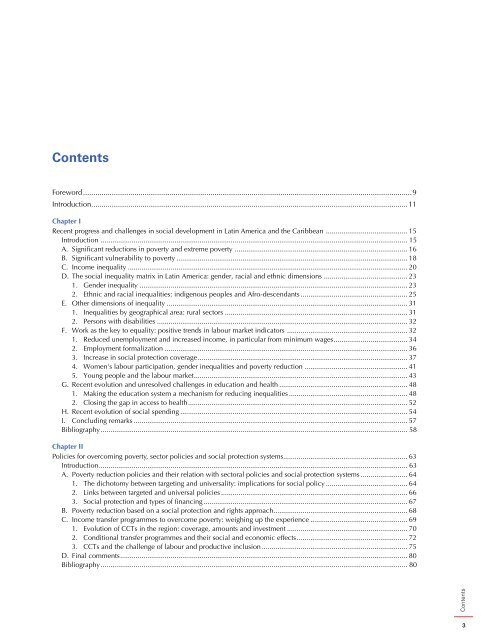Inclusive social development: The next generation of policies for overcoming poverty and reducing inequality in Latin America and the Caribbean
The Latin American and Caribbean region has achieved notable social development in the past decade. However, much remains to be done. The persisting challenges of defeating poverty once and for all and significantly reducing inequality are not only ethical imperatives but also conditions for making progress toward sustainable development, consistently with the recently adopted 2030 Agenda for Sustainable Development. Although the global economy is more complex and uncertain now than in previous years, and prospects for the region are not —in the short term, at least— particularly bright, it is crucial to secure the progress made in social development in the past decade and lose no time in tackling unresolved issues in areas where progress has been insufficient.
The Latin American and Caribbean region has achieved notable social development in the past decade. However, much remains to be done. The persisting challenges of defeating poverty once and for all and significantly reducing inequality are not only ethical imperatives but also conditions for making progress toward sustainable development, consistently with the recently adopted 2030 Agenda for Sustainable Development.
Although the global economy is more complex and uncertain now than in previous years, and prospects for the region are not —in the short term, at least— particularly bright, it is crucial to secure the progress made in social development in the past decade and lose no time in tackling unresolved issues in areas where progress has been insufficient.
You also want an ePaper? Increase the reach of your titles
YUMPU automatically turns print PDFs into web optimized ePapers that Google loves.
Contents<br />
Foreword.................................................................................................................................................................9<br />
Introduction...........................................................................................................................................................11<br />
Chapter I<br />
Recent progress <strong>and</strong> challenges <strong>in</strong> <strong>social</strong> <strong>development</strong> <strong>in</strong> Lat<strong>in</strong> <strong>America</strong> <strong>and</strong> <strong>the</strong> <strong>Caribbean</strong> ........................................... 15<br />
Introduction ............................................................................................................................................................... 15<br />
A. Significant reductions <strong>in</strong> <strong>poverty</strong> <strong>and</strong> extreme <strong>poverty</strong> .......................................................................................... 16<br />
B. Significant vulnerability to <strong>poverty</strong>........................................................................................................................ 18<br />
C. Income <strong><strong>in</strong>equality</strong>................................................................................................................................................. 20<br />
D. <strong>The</strong> <strong>social</strong> <strong><strong>in</strong>equality</strong> matrix <strong>in</strong> Lat<strong>in</strong> <strong>America</strong>: gender, racial <strong>and</strong> ethnic dimensions ............................................ 23<br />
1. Gender <strong><strong>in</strong>equality</strong>........................................................................................................................................... 23<br />
2. Ethnic <strong>and</strong> racial <strong>in</strong>equalities: <strong>in</strong>digenous peoples <strong>and</strong> Afro-descendants........................................................ 25<br />
E. O<strong>the</strong>r dimensions <strong>of</strong> <strong><strong>in</strong>equality</strong>............................................................................................................................. 31<br />
1. Inequalities by geographical area: rural sectors............................................................................................... 31<br />
2. Persons with disabilities.................................................................................................................................. 32<br />
F. Work as <strong>the</strong> key to equality: positive trends <strong>in</strong> labour market <strong>in</strong>dicators ............................................................... 32<br />
1. Reduced unemployment <strong>and</strong> <strong>in</strong>creased <strong>in</strong>come, <strong>in</strong> particular from m<strong>in</strong>imum wages....................................... 34<br />
2. Employment <strong>for</strong>malization.............................................................................................................................. 36<br />
3. Increase <strong>in</strong> <strong>social</strong> protection coverage............................................................................................................. 37<br />
4. Women's labour participation, gender <strong>in</strong>equalities <strong>and</strong> <strong>poverty</strong> reduction ..................................................... 41<br />
5. Young people <strong>and</strong> <strong>the</strong> labour market............................................................................................................... 43<br />
G. Recent evolution <strong>and</strong> unresolved challenges <strong>in</strong> education <strong>and</strong> health................................................................... 48<br />
1. Mak<strong>in</strong>g <strong>the</strong> education system a mechanism <strong>for</strong> <strong>reduc<strong>in</strong>g</strong> <strong>in</strong>equalities.............................................................. 48<br />
2. Clos<strong>in</strong>g <strong>the</strong> gap <strong>in</strong> access to health.................................................................................................................. 52<br />
H. Recent evolution <strong>of</strong> <strong>social</strong> spend<strong>in</strong>g...................................................................................................................... 54<br />
I. Conclud<strong>in</strong>g remarks.............................................................................................................................................. 57<br />
Bibliography............................................................................................................................................................... 58<br />
Chapter II<br />
Policies <strong>for</strong> <strong>overcom<strong>in</strong>g</strong> <strong>poverty</strong>, sector <strong>policies</strong> <strong>and</strong> <strong>social</strong> protection systems................................................................ 63<br />
Introduction................................................................................................................................................................ 63<br />
A. Poverty reduction <strong>policies</strong> <strong>and</strong> <strong>the</strong>ir relation with sectoral <strong>policies</strong> <strong>and</strong> <strong>social</strong> protection systems......................... 64<br />
1. <strong>The</strong> dichotomy between target<strong>in</strong>g <strong>and</strong> universality: implications <strong>for</strong> <strong>social</strong> policy........................................... 64<br />
2. L<strong>in</strong>ks between targeted <strong>and</strong> universal <strong>policies</strong>................................................................................................. 66<br />
3. Social protection <strong>and</strong> types <strong>of</strong> f<strong>in</strong>anc<strong>in</strong>g.......................................................................................................... 67<br />
B. Poverty reduction based on a <strong>social</strong> protection <strong>and</strong> rights approach...................................................................... 68<br />
C. Income transfer programmes to overcome <strong>poverty</strong>: weigh<strong>in</strong>g up <strong>the</strong> experience................................................... 69<br />
1. Evolution <strong>of</strong> CCTs <strong>in</strong> <strong>the</strong> region: coverage, amounts <strong>and</strong> <strong>in</strong>vestment............................................................... 70<br />
2. Conditional transfer programmes <strong>and</strong> <strong>the</strong>ir <strong>social</strong> <strong>and</strong> economic effects.......................................................... 72<br />
3. CCTs <strong>and</strong> <strong>the</strong> challenge <strong>of</strong> labour <strong>and</strong> productive <strong>in</strong>clusion............................................................................ 75<br />
D. F<strong>in</strong>al comments..................................................................................................................................................... 80<br />
Bibliography............................................................................................................................................................... 80<br />
Contents<br />
3


















